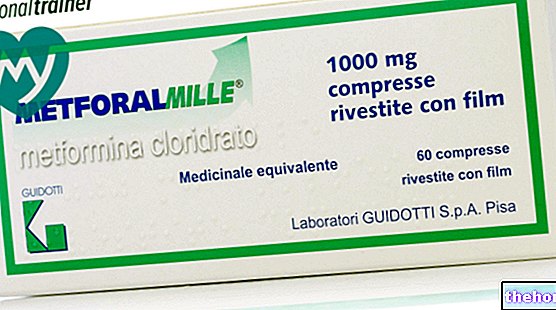Active ingredients: ethacrynic acid
REOMAX® 50 mg Tablets
REOMAX® Vials 50 mg / 20 ml
Indications Why is Reomax used? What is it for?
PHARMACOTHERAPEUTIC CATEGORY
Diuretics.
THERAPEUTIC INDICATIONS
REOMAX is indicated in all salt and water retention syndromes and in particular:
Edema of cardiac origin, edema of renal origin, nephrotic forms, chronic renal failure, cirrhosis with ascites, ascitogenic liver diseases. Intravenous administration of sodium ethacrylate (Reomax ampoules) is indicated when rapid onset of diuresis is required, such as in acute pulmonary edema.
Contraindications When Reomax should not be used
Known hypersensitivity to ethacrynic acid. Anuria. Reomax is also contraindicated in pregnant women, breastfeeding women and children under the age of two.
Precautions for use What you need to know before taking Reomax
Reomax should be administered with caution in patients with advanced liver cirrhosis, especially if the patient's history includes electrolyte imbalance or hepatic encephalopathy. Reomax, like other diuretics, can lead to hepatic coma and death.
In patients treated with digitalis glycosides, excessive loss of potassium can lead to digitalis toxicity.
Particular care should be taken for those patients who are given potassium-depleted steroids.
The possibility of using Reomax safely and effectively in hypertension has not yet been ascertained; however, if the patient treated with Reomax is already under treatment with antihypertensives, the dosage of the latter may need to be adjusted. When administering ethacrynic acid to patients orthostatic hypotension may occur already in treatment with antihypertensives. Ethacrynic acid has little or no effect on glomerular filtration rate or renal plasma flow, except immediately after a marked reduction in plasma volume, when associated with rapid diuresis. A transient increase in blood urea nitrogen may occur and is usually readily reversible upon discontinuation of the drug.
Interactions Which drugs or foods can modify the effect of Reomax
Ethacrynic acid has been shown to displace warfarin from plasma proteins; patients receiving both drugs may require a reduction in the usual anti-coagulant dosage.
Ethacrynic acid may increase the ototoxic potential of other drugs such as aminoglucoside antibiotics (see side effects), so the use of these drugs should be avoided during treatment with Reomax.
Lithium should not be given to patients under diuretic treatment, as the risk of lithium toxicity is very high in such individuals.
Warnings It is important to know that:
Use in pregnancy and lactation
In pregnancy and during lactation the use of the drug is contraindicated.
SPECIAL WARNINGS
Ethacrinic acid, especially if used in high doses, can induce profound diuresis with water and electrolyte depletion. Following intense or excessive diuresis, weakness, muscle cramps, paraesthesia, thirst, anorexia and signs of hyponatremia, hypokalaemia and / o hypochloraemic alkalosis which can be accentuated due to a rigid salt restriction. Cases of tetany resulting from massive diuresis have rarely been reported. The possibility of severe loss of salts and water can be minimized by adjusting the dosage, by intermittent administration of the drug, by reintegrating the saline quota and periodically checking the patient's weight. During the treatment it will therefore sometimes be necessary a certain liberalization in the intake of salt with the diet and the additional addition of sodium chloride.
Hypokalaemia due to diuretic therapy can be avoided by recommending the abundant consumption of certain types of fruit, fruit juices or other foods rich in potassium, or, if necessary, with the additional administration of potassium; in the latter case it is advisable to use only salts in liquid form. In cases where metabolic alkalosis may be expected, for example in ascitogenic cirrhosis, the administration of potassium chloride with or without an antikaliuretic, before and throughout the treatment with Reomax, may decrease the extent or prevent the onset of hypokalaemia. Too vigorous diuresis, which can be evidenced by rapid and excessive weight loss, can cause an acute hypotensive episode. In elderly cardiac patients, large diuresis can cause rapid reduction in plasma volume and a concentration that should be avoided in order to prevent any thromboembolic episodes.
Use of cars / driving of vehicles
No negative effects of the preparation on these activities are reported or expected.
For those who carry out sports activities
The use of the drug without therapeutic necessity constitutes doping and can in any case determine positive anti-doping tests.
Dosage and method of use How to use Reomax: Dosage
The treatment must be carried out under the supervision of the doctor who will adapt the dosage to the severity of the case.
Tablets
Recommended starting dose: 1 tablet of 50 mg to be administered in the morning on a full stomach. The effective daily dose is usually between 50-150 mg of ethacrynic acid to be always administered after meals. In particularly severe cases, the daily dose can be gradually increased up to a maximum of 200-250 mg of ethacrynic acid. In maintenance therapy it is advisable to administer Reomax every other day or to follow two or three days of therapy with two or three days off.
IV ampoules
The standard intravenous dose for an average weight adult is 50 mg of ethacrynic acid (1 ampoule) or 0.5-1 mg per kg of body weight. A second administration is rarely necessary and in this case it is advisable to change the injection site to avoid the possibility of thrombophlebitis.
To solubilize the lyophilisate (vial A) dissolve it in 20-40 ml of glucose solution (vial B). The solution obtained can be used in the following ways:
a) direct intravenous injection over a period of several minutes.
b) during a drip, by slow infusion into the infusion set.
Overdose What to do if you have taken too much Reomax
In case of overdose, profound diuresis with hydroelectrolytic depletion may be induced with the possibility of dehydration.
It intervenes by integrating in an appropriate way the electrolytes and the liquids lost.
Side Effects What are the side effects of Reomax
Gastointestinal disturbances include anorexia, malaise, abdominal aches or pains, dysphagia, nausea, vomiting, and diarrhea. They have occurred more frequently with the use of higher doses after 1-3 months of uninterrupted therapy. In some patients the drug has caused severe watery diarrhea. In this event, the administration of the preparation should be interrupted and not restarted. Gastrointestinal haemorrhage has occurred in some patients; ethacrynic acid may also increase the risk of gastric haemorrhage associated with corticosteroid treatment.
Reversible hyperuricaemia, decreased urinary excretion of urates and acute gout attacks may occur. Two uremic patients, given higher than recommended doses, experienced symptomatic acute hypoglycemia with convulsions. Hypoglycaemia occurred in some patients, mostly part affected by decompensated liver cirrhosis.
Cases of acute pancreatitis have been reported rarely in patients receiving diuretic therapy, including Reomax. Jaundice and abnormal hepatocellular function tests have rarely been found, especially in very severe patients. Severe agranulocytosis and neutropenia have been found in some patients in very serious conditions and who were simultaneously administered other drugs that can produce these effects. Thrombocytopenia was rarely encountered. Rare cases of Schonlein-Henoch purpura have been reported in cardioreumatics treated with many drugs, including Reomax.
In patients already seriously ill and refractory to other diuretics, some deaths have occurred which could be related to the administration of the drug. These patients typically fall into two groups:
- Cardiopathic patients with severe myocardial damage under digitalis treatment and in whom acute hypokalaemia with lethal arrhythmia was presumably established.
- Patients suffering from ascitogenic liver cirrhosis in severe decompensation, with or without electrolyte imbalance encephalopathy, in which the lethal outcome was due to worsening of the electrolyte situation.
Vertigo, deafness, buzzing occurred very frequently in patients with severe renal dysfunction. These symptoms occurred very often after intravenous administration and after administration in higher than recommended doses.
Deafness was usually reversible and of short duration (1 to 24 hours). In some patients, however, the hearing loss was permanent, especially if other drugs of known ototoxicity were administered in these subjects. apprehension and confusion.
Hematuria has rarely been reported.
The injections occasionally caused local irritation and pain due to transfer of the injected liquid.
Expiry and Retention
Be careful not to use the medicine after the expiry date indicated on the package.
KEEP OUT OF THE REACH AND SIGHT OF CHILDREN
Deadline "> Other information
QUALITATIVE AND QUANTITATIVE COMPOSITION
TABLETS
Each tablet contains:
- Active ingredient: 50 mg ethacrynic acid
- Excipients: Lactose - Starch - Magnesium stearate.
VIALS E.V.
- Each Lyophilized vial contains:
- Active ingredient: Sodium ethacrylate 53.63 mg (equal to 50 mg of ethacrynic acid).
- Excipients: Mannitol - Methyl p-oxybenzoate.
- Each solvent vial contains:
- Sterile glucose solution 5% ml 20.
PHARMACEUTICAL FORM AND PACKAGING
Reomax tablets:
Each pack contains: 20 tablets of 50 mg of ethacrynic acid.
Reomax vials i.v .:
Each pack contains: 1 ampoule A (lyophilisate) +1 ampoule B (solvent).
Source Package Leaflet: AIFA (Italian Medicines Agency). Content published in January 2016. The information present may not be up-to-date.
To have access to the most up-to-date version, it is advisable to access the AIFA (Italian Medicines Agency) website. Disclaimer and useful information.
01.0 NAME OF THE MEDICINAL PRODUCT -
REOMAX
02.0 QUALITATIVE AND QUANTITATIVE COMPOSITION -
REOMAX tablets
Each tablet contains:
Active principle:
Ethacrynic acid 50 mg
REOMAX vials E.V.
Each lyophilized vial contains:
Active principle:
Sodium ethacrylate 53.63 mg (equal to 50 mg of ethacrynic acid).
03.0 PHARMACEUTICAL FORM -
50 mg tablets
50 mg / 20 ml ampoules for intravenous use
04.0 CLINICAL INFORMATION -
04.1 Therapeutic indications -
REOMAX is indicated in all salt and water retention syndromes and in particular:
Edema of cardiac origin.
Edema of renal origin, nephrotic forms, chronic renal failure, cirrhosis with ascites, ascitogenic liver diseases.
Intravenous administration of sodium ethacrylate is particularly indicated in acute pulmonary edema.
04.2 Posology and method of administration -
The treatment must be carried out under the supervision of the doctor who will adapt the dosage to the severity of the case.
Tablets:
Recommended starting dose: 1 tablet of 50 mg to be administered in the morning on a full stomach. The effective daily dose is usually between 50-150 mg of ethacrynic acid.
In particularly severe cases, the daily dose can be gradually increased up to a maximum of 200-250 mg of ethacrynic acid. In maintenance therapy it is advisable to administer REOMAX every other day or to follow two or three days of therapy with two or three days off.
IV ampoules:
The standard intravenous dose for an average weight adult is 50 mg of ethacrynic acid (1 ampoule) or 0.5-1 mg per kg of body weight. A second administration is rarely necessary and in this case it is advisable to change the injection site to avoid the possibility of thrombophlebitis. To solubilize the lyophilisate (vial A) dissolve it in 20-40 ml of glucose solution (vial B).
The solution obtained can be used in the following ways:
direct intravenous injection over a period of several minutes.
during a drip, by slow infusion into the infusion set.
04.3 Contraindications -
Known hypersensitivity to ethacrynic acid. Anuria. REOMAX is also contraindicated in pregnant women, breastfeeding women and children under the age of two.
04.4 Special warnings and appropriate precautions for use -
Ethacrynic acid, especially if used in high doses, can induce profound diuresis with hydroelectric depletion.
Following intense or excessive diuresis, weakness, muscle cramps, paraesthesia, thirst, anorexia, hypokalaemia and hypochloraemic alkalosis can occur.
Hypokalaemia can be avoided by administering potassium supplements. Administration of this element in liquid form is recommended.
Too vigorous diuresis, which may be evidenced by subsequent weight loss, can cause acute hypotensive episodes.
In patients treated with digitalis glycosides, an excessive loss of potassium could lead to digitalis toxicity.
REOMAX should be administered with caution in patients with advanced liver cirrhosis. Like other diuretics it can lead to hepatic coma.
04.5 Interactions with other medicinal products and other forms of interaction -
Ethacrynic acid may increase the ototoxic potential of other drugs such as aminoglucoside antibiotics. During treatment with REOMAX, the use of these drugs should be avoided.
04.6 Pregnancy and breastfeeding -
REOMAX is contraindicated in both pregnant and breastfeeding women.
04.7 Effects on ability to drive and use machines -
Ethacrynic acid does not interfere with the ability to drive and use machines.
04.8 Undesirable effects -
Gastrointestinal disturbances include anorexia, abdominal pain, dysphagia, nausea, vomiting and diarrhea. They have occurred with the use of higher doses after 1-3 months of uninterrupted therapy. Reversible hyperuricaemia, decreased urinary excretion of urates and acute attacks of gout may occur following administration with ethacrynic acid. Hypoglycaemia has occurred in some patients, mostly with decompensated liver cirrhosis.
Dizziness, deafness, and humming occurred frequently in patients with severe renal dysfunction. These symptoms occurred very often after intravenous administration and after administration of higher than recommended doses.
Deafness was usually reversible and of short duration (1 to 24 hours).
In some patients, however, the hearing loss was permanent, especially if these subjects were administered drugs of known ototoxicity.
The injections occasionally caused local irritation and pain due to transfer of the injected liquid.
04.9 Overdose -
Discontinue treatment and correct the loss of electrolytes by administering salts (potassium).
05.0 PHARMACOLOGICAL PROPERTIES -
05.1 "Pharmacodynamic properties -
Ethacrynic acid is a potent ketone diuretic derived from aryloxyacetic acid. The sodium salt is soluble in water at 25 ° C up to 7%.The sodium salt solution at pH around 7 and at room temperature is stable for short periods.
REOMAX acts on the ascending branch of the loop of Henle and on the distal and proximal tubules. The excretion of water and electrolytes can increase many times compared to what is observed with thiazide diuretics since REOMAX inhibits the reabsorption of a greater quantity sodium. Therefore REOMAX is effective in many patients with significant renal insufficiency.
05.2 "Pharmacokinetic properties -
The onset of ethacrynic acid activity is rapid: 30 minutes after an oral dose, 5 minutes after an intravenous injection.
05.3 Preclinical safety data -
Acute toxicity:
LD50 orally in mice: 0.35 g per kg.
Chronic toxicity:
The ethacrynic acid administered for 6 months orally in mice at a dose of 10 mg / kg, when the animals were properly rehydrated, did not cause changes in the body weight of the treated compared to the controls, did not cause mortality, moreover the parameters haematological and biochemical enzymes are within the norm. The rehydration of the treated animals was necessary due to the diuretic activity of the ethacrynic acid.
Fetal toxicity:
Ethacrynic acid administered orally during pregnancy to the rabbit at a dose of 4 mg / kg caused a decrease in the number of live births, but the absence of fetal malformations.
06.0 PHARMACEUTICAL INFORMATION -
06.1 Excipients -
REOMAX tablets:
Lactose, starch, magnesium stearate.
REOMAX vials E.V .:
Each lyophilized vial contains: mannitol, methyl p-oxybenzoate.
Each solvent vial contains: sterile 5% glucose solution 20 ml.
06.2 Incompatibility "-
Sodium ethacrylate is incompatible with solutions or drugs with a pH lower than 5.
06.3 Period of validity "-
For both formulations a validity of 5 years is foreseen for intact packaging.
06.4 Special precautions for storage -
No special storage precautions are required.
06.5 Nature of the immediate packaging and contents of the package -
REOMAX tablets:
Each carton contains 20 tablets in PVC / Al blisters.
REOMAX vials E.V. :
Each pack contains 1 10 ml lyophilized vial + 1 20 ml solvent vial.
White neutral glass vials.
06.6 Instructions for use and handling -
No special instructions.
07.0 HOLDER OF THE "MARKETING AUTHORIZATION" -
MarvecsPharma Services S.r.l.
Via Felice Casati, 16 - 20124 Milan
08.0 MARKETING AUTHORIZATION NUMBER -
REOMAX tablets: AIC N ° 021033016
REOMAX vials E.V .: AIC N ° 021033028
09.0 DATE OF FIRST AUTHORIZATION OR RENEWAL OF THE AUTHORIZATION -
31/05/2005
10.0 DATE OF REVISION OF THE TEXT -
01/03/2006




























